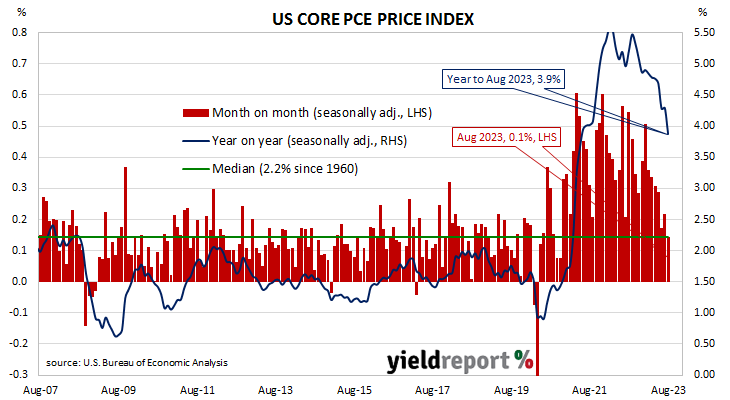Summary: US core PCE price index up 0.1% in August, less than expected; annual rate slows 4.3% to 3.9%; Treasury yields barely move; Fed rate-cut expectations for 2024 firm a little.
One of the US Fed’s favoured measures of inflation is the change in the core personal consumption expenditures (PCE) price index. After hitting the Fed’s target at the time of 2.0% in mid-2018, the annual rate then hovered in a range between 1.8% and 2.0% before it eased back to a range between 1.5% and 1.8% through 2019. It then plummeted below 1.0% in April 2020 before rising back to around 1.5% in the September quarter of that year. It has since increased significantly and still remains above the Fed’s target even after recent declines.
The latest figures have now been published by the Bureau of Economic Analysis as part of the August personal income and expenditures report. Core PCE prices rose by 0.1% over the month, less than the 0.2% increase which had been generally expected as well as July’s 0.2% increase. On a 12-month basis, the core PCE inflation rate slowed from July’s revised rate of 4.3% to 3.9%.
US Treasury bond yields barely moved on the day. By the close of business, the 2-year Treasury bond yield had slipped 1bp to 5.05% while 10-year and 30-year yields both finished unchanged at 4.58% and 4.71% respectively.
In terms of US Fed policy, expectations of a lower federal funds rate in the first half of 2024 firmed a little. At the close of business, contracts implied the effective federal funds rate would average 5.37% in November, slightly more than the current spot rate, 5.405% in December and 5.425% in January. September 2024 contracts implied 5.015%, 31bps less than the current rate.
The core version of PCE strips out energy and food components, which are volatile from month to month, in an attempt to identify the prevailing trend. It is not the only measure of inflation used by the Fed; the Fed also tracks the Consumer Price Index (CPI) and the Producer Price Index (PPI) from the Department of Labor. However, it is the one measure which is most often referred to in FOMC minutes.


